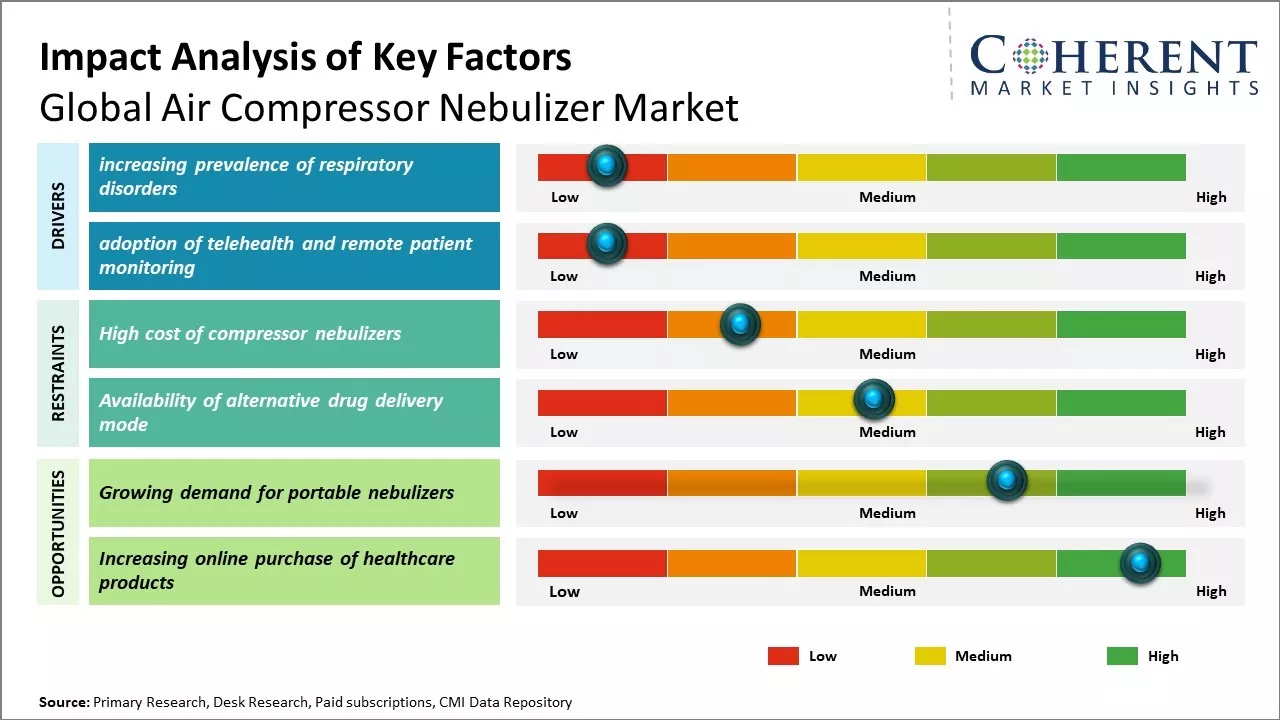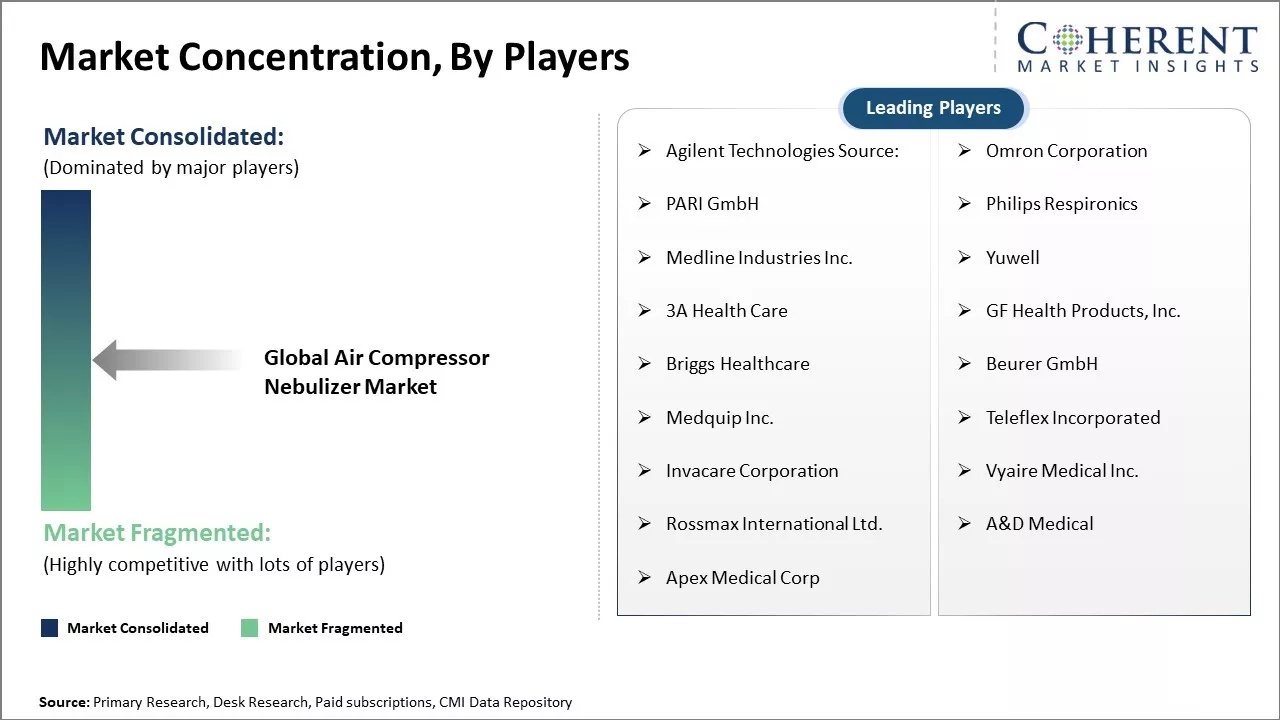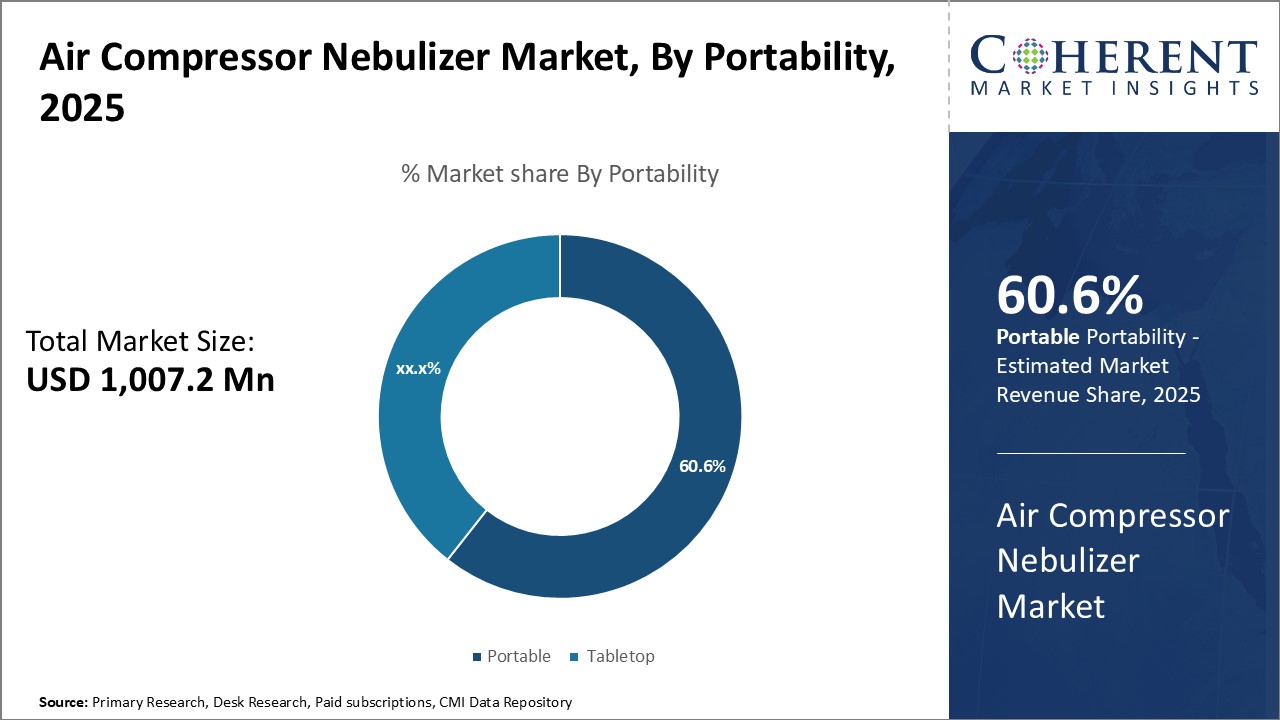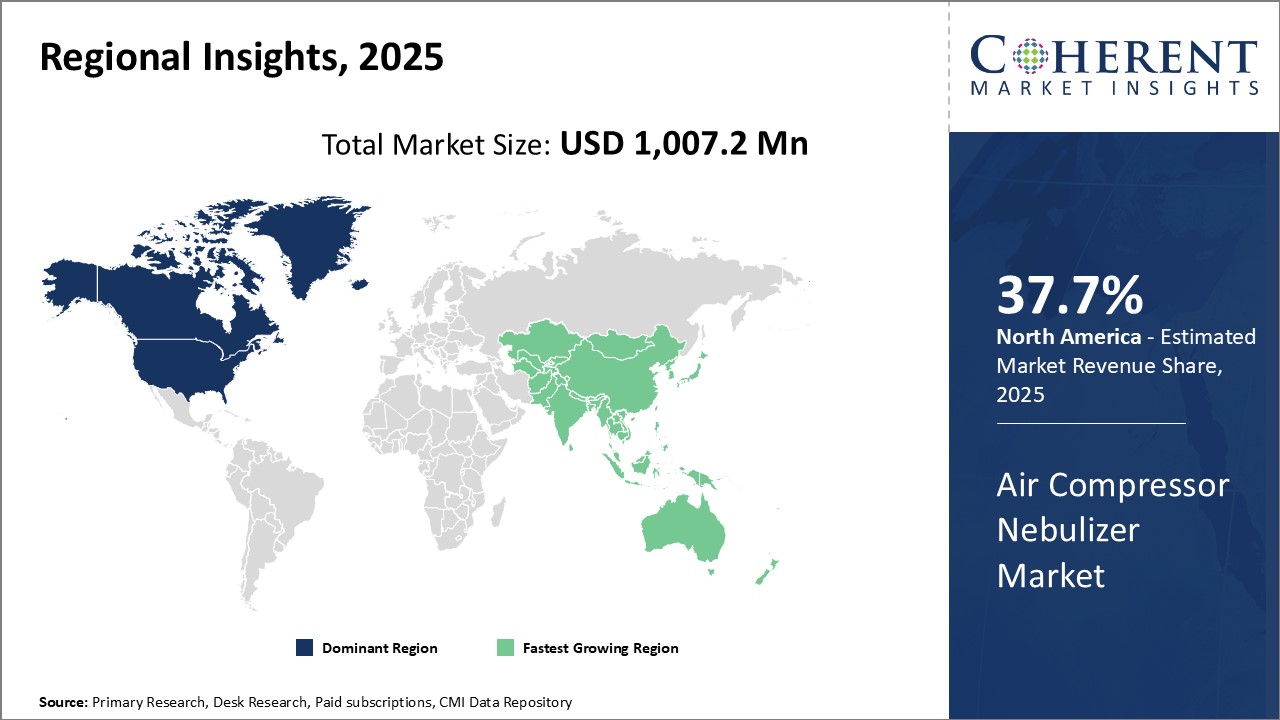Air Compressor Nebulizer Market Size and Trends
The global air compressor nebulizer market is estimated to be valued at USD 1,007.2 Mn in 2025 and is expected to reach USD 1,694.0 Mn by 2032, exhibiting a compound annual growth rate (CAGR) of 7.7% from 2025 to 2032.

Discover market dynamics shaping the industry: Download Free Sample
The air compressor nebulizer market is expected to grow steadily over the forecast period. Increasing prevalence of respiratory diseases around the world is the key factor driving the demand for air compressor nebulizers. As per research, respiratory diseases, such as asthma and COPD, chronic obstructive pulmonary disease (COPD) affect, millions worldwide. Air compressor nebulizers are widely used for effective drug delivery in homecare treatment of such diseases. Growing geriatric population prone to respiratory issues along with rising urbanization and pollution levels in emerging nations will drive the air compressor nebulizer market growth during the next few years. However, availability of alternative treatments and devices for respiratory diseases can hamper the market growth to some extent. Overall, enhanced patient awareness and expanding application areas of air compressor nebulizers are creating new opportunities in this market.
Increasing prevalence of respiratory disorders
The global air compressor nebulizer market is witnessing significant growth due to the increasing prevalence of various respiratory diseases across the globe. Respiratory diseases have become highly common due to rising air pollution levels and changing environmental conditions. Diseases such as asthma and chronic obstructive pulmonary disease (COPD) affect a substantial population worldwide and their management relies significantly on the usage of nebulizers. According to some estimates, over 339 million people suffer from asthma globally and it is one of the major causes of years lived with disability. COPD prevalence is also increasing rapidly and has emerged as the third leading cause of mortality. With growing pollution levels in urban areas and lifestyle changes contributing to sedentary routines, the risk of developing respiratory issues has enhanced considerably. This has augmented the therapeutic requirements for the effective administration of bronchodilators and other drugs meant for relieving asthma and COPD symptoms. Nebulizers allow for precise delivery of medication directly into the lungs via an aerosol mist. They are extensively used in acute exacerbations and emergency treatment of respiratory diseases. Furthermore, home care is being increasingly adopted for managing chronic conditions in order to avoid frequent hospital visits. This has further propelled the demand for compact and portable air compressor nebulizers from pharmaceutical companies and healthcare facilities. For instance, according to data by the World Health Organization (WHO), since mid-October 2023, WHO has monitored a surge in respiratory illnesses among children in Northern China. China's National Health Commission linked this rise to relaxed COVID-19 measures coinciding with colder weather, alongside circulating pathogens like influenza, Mycoplasma pneumoniae, RSV, and SARS-CoV-2. Reports of unexplained pneumonia clusters in children's hospitals prompted WHO to request detailed data from China for clarification. WHO remains engaged with clinical networks to gather further insights into these concerning developments.
Market Concentration and Competitive Landscape

Get actionable strategies to beat competition: Download Free Sample
Adoption of telehealth and remote patient monitoring
Another key driver for the air compressor nebulizer market is the rising adoption of digital health solutions and telemedicine services. The COVID-19 pandemic has heavily fueled investments in telehealth infrastructure and remote monitoring systems. During the various waves of the pandemic, non-critical patients were advised to avoid hospitals and seek consultations virtually through video conferencing with doctors. This necessitated the provision of medical devices and equipment that patients could utilize remotely under the supervision of physicians. Remote respiratory monitoring has emerged as an important element of telehealth. Platforms supporting features like wireless nebulizer triggers, dose and treatment trackers as well as two-way audio-visual capabilities are being extensively used. They facilitate the administration of therapy synchronously with medical guidance, thereby ensuring compliance to treatment and enabling intervention during adverse events. This telehealth model reduces infection exposure risks, relieves burden on hospitals, and makes therapy more affordable and accessible at home locations.
Key Takeaways from Analyst:
The global air compressor nebulizer market is poised to grow at a moderate pace over the forecast period owing to increasing incidence of respiratory diseases worldwide. Rise in geriatric population vulnerable to chronic obstructive pulmonary disease (COPD) and asthma will drive the demand for air compressor nebulizers. Additionally, advancements in nebulizer technologies offering more efficiency and portability is expected to support the market growth. The home healthcare segment is likely to witness the highest adoption of air compressor nebulizers as it allows patients to treat respiratory issues conveniently at home.
North America holds the top position in the market currently and is expected to retain its leading position in the coming years. Supportive reimbursement policies for COPD and asthma treatment in the U.S. and Canada fosters the market in the region. Meanwhile, the Asia Pacific air compressor nebulizer market will expand the fastest during the projection period owing to surge in healthcare expenditure and rising awareness about respiratory disorders in emerging economies like China and India.
However, the preference for alternative methods like metered dose inhalers and dry powder inhalers can hamper the market growth to some extent. Availability of low-cost generics also poses a threat. Nonetheless, growing respiratory allyl disorders population combined with increasing focus on personalized care presents significant opportunities for established as well as local players.
Market Challenges: High cost of compressor nebulizers
The high cost of compressor nebulizers is one of the major factors hindering the growth of the global air compressor nebulizer market. Compressor nebulizers tend to be more expensive than ultrasonic nebulizers or mesh nebulizers due to the additional compressor component that is required to function. According to a 2020 report by the World Health Organization, compressor nebulizers on average cost between US$ 150 and US$ 300 while ultrasonic nebulizers are priced around US$ 50 and US$ 100. This high initial purchase price of compressor nebulizers puts them out of reach for many consumers, especially those in lower-income countries and lower-income populations within developed countries. As a result, patients who could potentially benefit from compressor nebulizers due to their more efficient aerosol generation are forced to opt for cheaper but less effective alternatives. In addition, the high running costs of compressor nebulizers also act as a growth deterrent. Compressor nebulizers require electricity to power the compressor component which increases overall operational expenses over the lifetime of ownership. This is a barrier for regular consumers to adopt the technology. As an example, data from the International Energy Agency estimates that 16% of the population in Africa did not have access to electricity in 2020. For such populations, the running costs alone of compressor nebulizers can be prohibitive. Both the high purchase and operational expenses of compressor nebulizers negatively impact their accessibility. This widespread inaccessibility leads to lower adoption rates and restrained market growth potential especially in developing regions.
Market Opportunities: Growing demand for portable nebulizers
The demand for portable nebulizers is increasing globally as they offer convenience of use compared to traditional nebulizers. Portable nebulizers are compact, lightweight devices that can be easily carried anywhere. This allows people, especially those suffering from chronic respiratory conditions like asthma and COPD, to self-administer medication on the go. As lifestyles become increasingly mobile and fast-paced, the ability to treat breathing conditions anywhere and anytime provides unmatched flexibility and independence to users. Various macro factors are expected to contribute to the rising popularity of portable nebulizers. Rapid urbanization and growing pollution levels have led to a surge in respiratory illnesses over the past decade. According to the World Health Organization, asthma currently affects an estimated 262 million people worldwide and is becoming more prevalent each year. At the same time, infectious disease outbreaks like COVID-19 have highlighted the importance of effective respiratory ailments treatment. This growing disease burden and increasing health awareness are compelling more individuals to opt for portable nebulizers for maintenance medication and emergency relief during flare-ups.

Discover high revenue pocket segments and roadmap to it: Download Free Sample
By Portability - Convenience drives the demand for portable air compressor nebulizers
In terms of portability, portable is expected to contribute the highest share of the market with 60.6% of the market share in 2025 owing to convenience factors. Portable nebulizers are highly compact and lightweight, making them extremely easy to carry while traveling or moving between different locations. Their portability allows patients to receive treatments anywhere and anytime without being tied to a fixed location. This flexibility is a major advantage for active individuals or those suffering from chronic respiratory conditions who need regular nebulization therapy. Portable nebulizers also enable treatment at home, work or outdoors, giving users independence and freedom of movement. As lifestyle trends emphasize increased mobility and convenience, the demand for portable medical devices over tabletop versions continues growing steadily.
By Product Type - Technological advances fuel popularity of pneumatic nebulizers
In terms of product type, pneumatic nebulizers is expected to contribute the highest share of the market with 40.6% in 2025 owing to technological innovations. Pneumatic nebulizers operate using compressed air and are considered the oldest and most widely used type. However, continuous technical upgrades have made them highly effective and user-friendly. Advancements like increased mist particle sizes, variable mist outputs, and new designs improve medication delivery and ease of use. Pneumatic nebulizers also offer consistent and durable performance at lower costs compared to other segments. Their refinement has expanded applications across various therapeutic areas. Furthermore, knowledge and familiarity with pneumatic technology among doctors and patients have increased the commercialization of upgraded models. This entrenched preference and improved functionality have enabled pneumatic nebulizers to retain their market dominance.
By End User - Greater accessibility and affordability drive hospital dominance
In terms of end user, hospitals & clinics is expected to contribute the highest share of the market with 50.6% in 2025 owing to accessibility and affordability advantages. Hospitals are frequently the first point of contact for respiratory illness diagnostics and treatments. Their round-the-clock availability and on-site medical professionals make them a convenient option for emergency cases. Additionally, medical insurance often covers hospital expenses, making therapies more affordable for patients. Clinics also provide customized care suitable for chronic and long-term conditions. The prevalence of hospitals and clinics in most communities enhances their geographical reach. This widespread access has created a patient pool accustomed to utilizing respiratory services from such institutional settings. Further investments in new equipment additionally aid their leadership in the nebulizer market.
Regional Insights

Need a Different Region or Segment? Download Free Sample
North America has established itself as the dominant region in the global air compressor nebulizer market. The region is expected to account for 37.7% of the market share in 2025.The region enjoys strong industry presence from leading global medical device manufacturers who have set up their R&D and manufacturing hubs in countries like the U.S. and Canada. With higher per capita healthcare spending compared to other regions, the availability of technologically advanced nebulizers is higher. Moreover, favorable reimbursement policies for respiratory drugs and devices have boosted adoption rates over the years.
Key players, such as Aerogen, PARI, Omron, and Philips Respironics, have sizable market shares in North America owing to their recognized brand names and widespread distribution networks across hospitals and pharmacies. Private label brands from mass retailers are also popular choices for patients. North America is a price-sensitive market with strong purchase power. Manufacturers pursuing cost optimization through localization of production are able to offer competitive prices.
Moving forward, the Asia Pacific region is forecast to emerge as the fastest growing market for air compressor nebulizers. Rapid industrialization and economic development of countries like China, India, and Vietnam has led to rising pollution levels and increased incidence of respiratory ailments. An aging population demographic prone to chronic obstructive pulmonary disease (COPD) and asthma also contributes to the market growth.
Market Report Scope
Air Compressor Nebulizer Market Report Coverage
| Report Coverage | Details | ||
|---|---|---|---|
| Base Year: | 2024 | Market Size in 2025: | USD 1,007.2 Mn |
| Historical Data for: | 2020 To 2024 | Forecast Period: | 2025 To 2032 |
| Forecast Period 2025 to 2032 CAGR: | 7.7% | 2032 Value Projection: | USD 1,694.0 Mn |
| Geographies covered: |
|
||
| Segments covered: |
|
||
| Companies covered: |
Agilent Technologies Source: , Omron Corporation, PARI GmbH, Philips Respironics, Medline Industries Inc., Yuwell, 3A Health Care, GF Health Products, Inc., Briggs Healthcare, Beurer GmbH, Medquip Inc., Teleflex Incorporated, Invacare Corporation, Vyaire Medical Inc., Rossmax International Ltd., A&D Medical, and Apex Medical Corp |
||
| Growth Drivers: |
|
||
| Restraints & Challenges: |
|
||
Uncover macros and micros vetted on 75+ parameters: Get instant access to report
Air Compressor Nebulizer Industry News
- In May 2024, Medline, a healthcare company, introduced the Hudson RCI TurboMist small-volume nebulizer, which delivers medication in just three minutes, significantly faster than traditional nebulizers that take around 10 minutes. TurboMist administers medication 2.5 times more quickly per minute than standard nebulizers, providing nearly 70% faster treatment.
- In June 2022 UNICEF the United Nations International Children's Emergency Fund, acquired and transported 160 superior nebulizers to Iran at the request of the Ministry of Health and Medical Education of Iran. The fund was made possible by donations from Tejarat Bank, Saman Bank, and Edge Business Group. Children with cystic fibrosis (CF), a genetic illness predominantly affecting the lungs that causes mucus buildup and causes breathing difficulties and recurrent infections, are the target audience for these nebulizers.
- In May 2023 PARI, a company in medical devices and pharmaceuticals focused on respiratory and inhalation, announced the acquisition of Nortev, an Irish company known for producing the equine nebulizer Flexineb. Flexineb is used for respiratory therapy in horses to administer medication or saline via nebulization. Nortev also provides nebulization devices tailored for companion animals.
- On March 23, 2021, PARI Pharma GmbH, a company focused on medical devices and pharmaceuticals announced the authorization of the LAMIRA Nebulizer System in Japan for delivering Insmed's ARIKAYCE (amikacin liposome inhalation suspension). ARIKAYCE received approval from Japan’s Ministry of Health, Labour and Welfare (MHLW) following approvals in the U.S. and Europe. LAMIRA marks the first eFlow Technology nebulizer registered for a specific drug outside of Europe and North America.
*Definition: The global air compressor nebulizer market involves medical devices that use compressed air to deliver medication in the form of a mist inhaled into the lungs. Air compressor nebulizers provide treatments for respiratory conditions like asthma, COPD, and cystic fibrosis by quickly transforming liquid medications into aerosol particles small enough to reach deep into the airways. Top players in this market manufacture and sell a variety of air compressor nebulizers that are small, portable, and suitable for both hospital and home use globally. The devices provide effective drug delivery for respiratory therapies in a convenient way.
Market Segmentation
- Portability Insights (Revenue, USD Mn, 2020 - 2032)
- Portable
- Tabletop
- Product Type Insights (Revenue, USD Mn, 2020 - 2032)
- Pneumatic nebulizers
- Ultrasonic nebulizers
- Mesh nebulizers
- Breath-Actuated nebulizers
- Others
- End User Insights (Revenue, USD Mn, 2020 - 2032)
- Hospitals & Clinics
- Home healthcare settings
- Diagnostic Laboratories
- Others
- Regional Insights (Revenue, USD Mn, 2020 - 2032)
- North America
- U.S.
- Canada
- Latin America
- Brazil
- Argentina
- Mexico
- Rest of Latin America
- Europe
- Germany
- U.K.
- Spain
- France
- Italy
- Russia
- Rest of Europe
- Asia Pacific
- China
- India
- Japan
- Australia
- South Korea
- ASEAN
- Rest of Asia Pacific
- Middle East
- GCC Countries
- Israel
- Rest of Middle East
- Africa
- South Africa
- North Africa
- Central Africa
- North America
- Key Players Insights
- Agilent Technologies Source:
- Omron Corporation
- PARI GmbH
- Philips Respironics
- Medline Industries Inc.
- Yuwell
- 3A Health Care
- GF Health Products, Inc.
- Briggs Healthcare
- Beurer GmbH
- Medquip Inc.
- Teleflex Incorporated
- Invacare Corporation
- Vyaire Medical Inc.
- Rossmax International Ltd.
- A&D Medical
- Apex Medical Corp
Share
Share
About Author
Manisha Vibhute is a consultant with over 5 years of experience in market research and consulting. With a strong understanding of market dynamics, Manisha assists clients in developing effective market access strategies. She helps medical device companies navigate pricing, reimbursement, and regulatory pathways to ensure successful product launches.
Missing comfort of reading report in your local language? Find your preferred language :
Transform your Strategy with Exclusive Trending Reports :
Frequently Asked Questions
EXISTING CLIENTELE
Joining thousands of companies around the world committed to making the Excellent Business Solutions.
View All Our Clients
